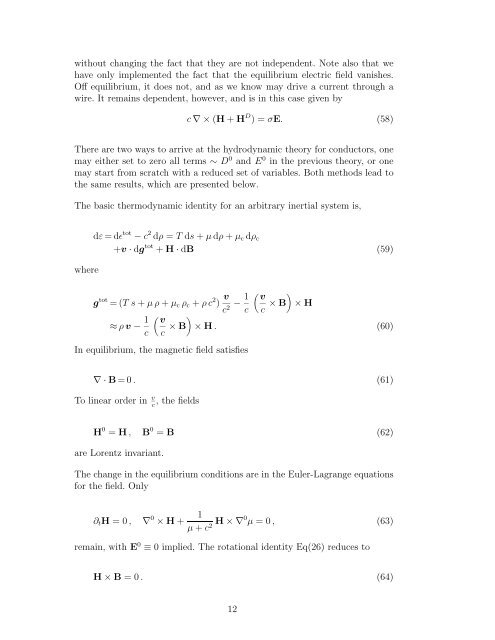pdf-file - Institut für Theoretische Physik
pdf-file - Institut für Theoretische Physik
pdf-file - Institut für Theoretische Physik
Create successful ePaper yourself
Turn your PDF publications into a flip-book with our unique Google optimized e-Paper software.
without changing the fact that they are not independent. Note also that we<br />
have only implemented the fact that the equilibrium electric field vanishes.<br />
Off equilibrium, it does not, and as we know may drive a current through a<br />
wire. It remains dependent, however, and is in this case given by<br />
c ∇×(H + H D )=σE. (58)<br />
There are two ways to arrive at the hydrodynamic theory for conductors, one<br />
may either set to zero all terms ∼ D 0 and E 0 in the previous theory, or one<br />
may start from scratch with a reduced set of variables. Both methods lead to<br />
the same results, which are presented below.<br />
The basic thermodynamic identity for an arbitrary inertial system is,<br />
where<br />
dε =dɛ tot − c 2 dρ = T ds + µ dρ + µc dρc<br />
+v · dg tot + H · dB (59)<br />
g tot =(Ts+ µρ+ µc ρc + ρc 2 ) v<br />
<br />
1 v<br />
− × B × H<br />
c2 c c<br />
≈ ρ v − 1<br />
<br />
v<br />
× B × H . (60)<br />
c c<br />
In equilibrium, the magnetic field satisfies<br />
∇·B =0. (61)<br />
To linear order in v,<br />
the fields<br />
c<br />
H 0 = H , B 0 = B (62)<br />
are Lorentz invariant.<br />
The change in the equilibrium conditions are in the Euler-Lagrange equations<br />
for the field. Only<br />
∂tH =0, ∇ 0 × H + 1<br />
µ + c 2 H ×∇0 µ =0, (63)<br />
remain, with E 0 ≡ 0 implied. The rotational identity Eq(26) reduces to<br />
H × B =0. (64)<br />
12
















